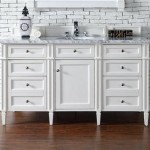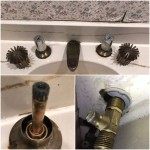Installing A Bathroom Vanity Cabinet: A Comprehensive Guide
The installation of a bathroom vanity cabinet represents a significant upgrade for both functionality and aesthetics. A well-chosen and properly installed vanity can transform a dated or inefficient bathroom into a modern and organized space. This article provides a detailed, step-by-step guide to successfully installing a new bathroom vanity cabinet, covering essential preparation, removal of the old vanity, installation of the new unit, and necessary plumbing connections. This process requires careful attention to detail and a moderate level of DIY proficiency.
Before embarking on this project, it’s crucial to understand the scope of work involved. This includes identifying the type of vanity being installed (floor-mounted, wall-mounted, or furniture-style), assessing the existing plumbing (supply lines and drain), and ensuring compatibility between the new vanity and the existing plumbing configuration. Failure to adequately plan can lead to complications and delays during the installation process. It is also important to familiarize yourself with local building codes and regulations regarding plumbing and electrical work, as these may dictate specific requirements for installation.
Furthermore, safety should be a primary concern throughout the project. This includes wearing appropriate personal protective equipment (PPE) such as safety glasses, gloves, and a dust mask. Disconnecting the water supply and electricity to the area is paramount before commencing any work. Working in a well-ventilated space is also important, especially when using adhesives or sealants.
1. Preparation: Gathering Tools and Materials and Assessing the Existing Site
Before any physical work begins, thorough preparation is essential. This involves gathering all necessary tools and materials, as well as carefully assessing the existing bathroom layout and plumbing. The tools required for this project typically include:
- Tape measure
- Level (both spirit level and laser level, if available)
- Pencil
- Screwdriver (both flathead and Phillips head)
- Adjustable wrench
- Pipe wrench
- Pliers
- Utility knife
- Caulk gun
- Stud finder
- Drill with various drill bits
- Hole saw (for drilling drain and supply line holes)
- Safety glasses
- Gloves
- Dust mask
The materials needed typically include:
- New bathroom vanity cabinet
- Shims (for leveling the vanity)
- Construction adhesive
- Caulk (silicone or acrylic latex)
- Plumber's putty
- Supply lines (if needed)
- Drain pipe extensions (if needed)
- P-trap (if needed)
- Shut-off valves (if needed)
- Screws or bolts (for securing the vanity to the wall)
With tools and materials gathered, the current bathroom must be carefully assessed. Measure the space where the new vanity will be installed to ensure it fits properly. Check the location of the existing plumbing (supply lines and drain) and compare it to the configuration of the new vanity. Determine if any modifications to the plumbing will be necessary. Locate wall studs using a stud finder, as these will be crucial for securely mounting the vanity. Note the existing wall and floor condition, assessing for any unevenness or damage that could affect the installation.
Finally, before removing the old vanity, take pictures of the existing plumbing connections. This documentation can be invaluable when reconnecting the plumbing to the new vanity, serving as a visual reference to ensure proper connections are made.
2. Removal of the Old Vanity Cabinet
The removal process should be approached systematically to minimize damage to surrounding surfaces and avoid plumbing-related issues. The initial step involves shutting off the water supply to the vanity. Locate the shut-off valves under the sink, typically found on the supply lines leading to the faucet. Turn these valves clockwise until completely closed. If shut-off valves are not present, the main water supply to the house must be shut off. After shutting off the water supply, turn on the faucet to relieve any remaining pressure in the lines.
Next, disconnect the supply lines from the faucet. Place a bucket or towels underneath to catch any residual water. Use an adjustable wrench to loosen the connections and carefully detach the supply lines. Disconnect the drainpipe from the sink drain. Loosen the slip nuts connecting the drainpipe to the P-trap and the P-trap to the drainpipe in the wall. Again, have a bucket or towels ready to catch any water or debris. Once the drainpipe is disconnected, remove the old faucet from the sink, if applicable. This usually involves loosening nuts or screws underneath the sink.
With the plumbing disconnected, the old vanity can be detached from the wall. Typically, vanities are attached to the wall studs with screws or bolts. Locate these fasteners and remove them using a screwdriver or wrench. If the vanity is also adhered to the wall with caulk, use a utility knife to carefully score along the edges to break the seal. Once all fasteners are removed, carefully lift or slide the old vanity away from the wall. Be mindful of its weight and enlist assistance if necessary to prevent injury. Dispose of the old vanity responsibly.
After removing the old vanity, inspect the area for any damage or debris. Clean the wall and floor thoroughly, removing any old caulk, adhesive, or debris. This will provide a clean surface for installing the new vanity. Repair any wall damage, such as holes or cracks, before proceeding.
3. Installing the New Vanity Cabinet and Connecting the Plumbing
The installation of the new vanity involves careful placement, leveling, and secure attachment to the wall. Begin by positioning the new vanity in the designated space. Use shims to level the vanity, ensuring it is perfectly level both front-to-back and side-to-side. A level should be used to verify the accuracy of the shims. Once the vanity is level, mark the location of the wall studs on the back of the vanity cabinet. These marks will guide the placement of screws or bolts for securing the vanity to the wall.
Pre-drill pilot holes through the back of the vanity cabinet and into the wall studs. This will make it easier to drive screws or bolts and prevent the wood from splitting. Apply construction adhesive to the back of the vanity cabinet where it will contact the wall. This will provide additional support and stability. Using appropriate screws or bolts, securely fasten the vanity to the wall studs. Ensure the screws or bolts are long enough to penetrate deeply into the studs and provide a secure hold. Once the vanity is securely attached to the wall, double-check that it is still level and adjust the shims as needed.
Now, connect the plumbing to the new vanity. Install the faucet according to the manufacturer's instructions. This typically involves inserting the faucet into the sink and tightening the mounting hardware underneath. Connect the supply lines to the faucet. Use Teflon tape on the threads to create a watertight seal. Tighten the connections with an adjustable wrench, being careful not to overtighten and damage the fittings. Install the drain assembly according to the manufacturer's instructions. This typically involves inserting the drain flange into the sink drain and tightening the nut underneath. Apply plumber's putty to the underside of the drain flange to create a watertight seal.
Connect the P-trap to the drain assembly and the drainpipe in the wall. Ensure all connections are tight and secure. Turn on the water supply to the vanity and check for leaks. Carefully inspect all connections (supply lines, drainpipe, and P-trap) for any signs of leakage. Tighten connections as needed to eliminate any leaks. Run water in the sink to test the drainage. Ensure the water drains freely and there are no obstructions in the drainpipe.
Finally, apply caulk around the edges of the vanity where it meets the wall and the floor. This will create a watertight seal and prevent water from seeping behind the vanity. Use a caulk gun to apply a bead of caulk along the edges and smooth it out with a wet finger or a caulk smoothing tool. Allow the caulk to dry completely before using the vanity.
The final step is to clean up the work area and dispose of any debris. Remove all tools and materials from the bathroom. Wipe down the vanity and surrounding surfaces with a damp cloth. Inspect the installation one last time to ensure everything is properly aligned and functioning correctly.

How To Install A Bathroom Vanity

How To Install A Bathroom Vanity

How To Install Or Remove A Bathroom Vanity Homeserve Usa

How To Install A Bathroom Vanity 4 Easy Steps

How To Install A Vanity Forbes Home

How To Install A Bathroom Vanity 101

Tutorial How To Install A Bathroom Vanity The Diy Playbook

12 Easy Steps To Install Bathroom Vanity And Sink

Tutorial How To Install A Bathroom Vanity The Diy Playbook

How To Replace Install A Bathroom Vanity And Sink Small Vanities Diy Tops
Related Posts







